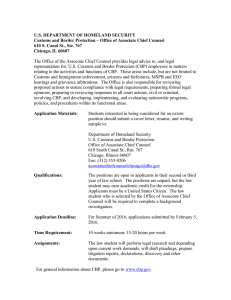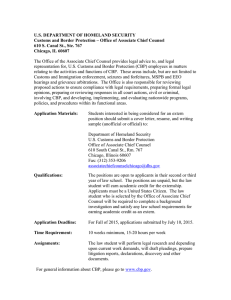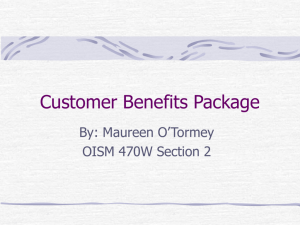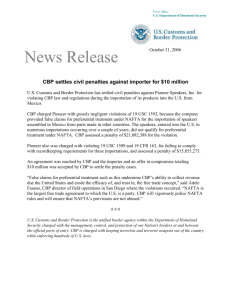Slides
advertisement
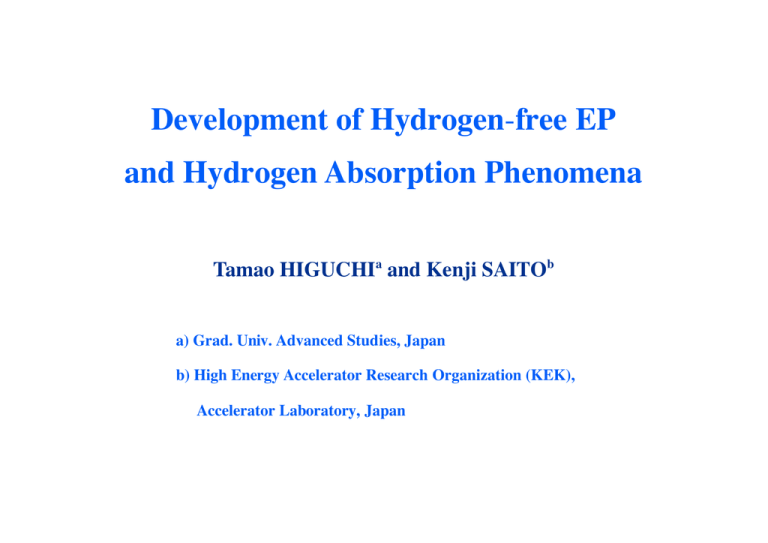
Development of Hydrogen-free EP and Hydrogen Absorption Phenomena Tamao HIGUCHIa and Kenji SAITOb a) Grad. Univ. Advanced Studies, Japan b) High Energy Accelerator Research Organization (KEK), Accelerator Laboratory, Japan Contents Introduction Pursuit the cause for hydrogen Q-disease No hydrogen Q-disease after ElectroPolishing (EP) only Hydrogen absorption in Centrifugal Barrel Polishing (CBP) Hydrogen absorption in Centrifugal Barrel Polishing (CBP) Surface defects and absorption of hydrogen Innovation of H-free CBP Hydrogen Q-disease caused by a combination of H-free CBP and EP Solution for the hydrogen Q-disease H-free CBP + Chemical Polishing (CP) H-free CBP + oxidizer added EP Conclusion Introduction Requirements on Surface Treatment for Superconducting(SC) RF Cavities 1) High Performance: High Gradient & High Q 2) High Reliability 3) Cost-effective Purpose of mechanical grinding Embedded Cracks Sputter balls Mechanical grinding is a powerful method to remove surface defects Centrifugal Barrel Polishing (CBP) Chemical Polishing (CP) CP solution: Equal mixture of HF(46%), HNO3(60%) and H3PO4(85%) Horizontal Continuous Electropolishing (EP) TRISTAN EP solution: mixture of HF(46%) and H2SO4(95%) Electropolishing (EP) is the preferred technology in KEK Higher gradient achievable with EP 10 11 Q0 10 10 10 9 10 80 10 20 30 E acc [MV/m] 40 CBP + pre-EP + EP: Hydrogen Q-disease 10 11 10 10 Q0 10 9 Fast cooling down (1hour) kept at ~ 100K for 16hours CBP + pre-EP + EP 50µm 10 8 10 7 0 5 10 E acc [MV/m] 15 20 Discovered: EP-alone does not cause Hydrogen Q-disease. (KEK 1999) 40 35 Fast cooling down (1 hour) kept at ~ 100K for 16 hours 30 Rres [ W] 25 20 15 10 5 0 0 50 100 150 200 Removed thickness with EP [µm] 250 Hydrogen-free CBP Liquid used for CBP Hydrogen concentration comments in the test sample Annealing 1.0±0.2 分析前処理 Annealing 1.0±0.2[ppm] [ppm] sample conditioning Soapy water 78.0±2.9 [ppm] (water + compound) Demineralized water 79.1±5.0 [ppm] Standard composition No compound (Stones only) 10.9±0.8 [ppm] 無水プロパノール Propanol (C33H H77OH) OH) (C FC-77 FC-77 (C (C88FF18、 18、C C88FF1616O) O) 49.4±2.2 [ppm] [ppm] 水無し No water 4.6±2.2 4.6±2.2 [ppm] [ppm] 水素無し No hydrogen (test samples: 2.5mm(H) x 1.0mm(W) x 147mm(L), RRR=200) H-free CBP + pre-EP + EP: Hydrogen Q-disease 10 11 Fast cooling down (1 hour) kept at ~ 100 K for 16 hours 10 10 Qo 10 9 H-free CBP (FC-77) + pre-EP + EP 50 µm 10 8 10 7 0 5 10 E acc [MV/m] 15 20 H-free CBP + CP: No Hydrogen Q-disease 10 11 10 10 Q0 10 9 Fast cooling down (1hour) kept at ~ 100 K for 16 hours 10 8 H-free CBP (FC-77) + CP 50 µm 10 7 0 5 10 15 E acc [MV/m] 20 25 Amount of hydrogen [ppm by weight] H-free CBP + EP: Hydrogen absorption H-free CBP + CP: No Hydrogen absorption 20 H-free CBP + EP H-free CBP + CP 15 10 5 0 0 1 Removed thickness with EP or CP [µm] H-free CBP + pre-EP (HNO3) + EP: No Hydrogen Q-disease 10 11 10 10 Q0 H-free CBP(FC-77) + pre-EP(HNO 3 ) + EP 50µm 10 9 Fast cooling down (1hour) kept at ~ 100K for 16hours 10 8 10 7 0 10 11 5 10 15 20 E acc [MV/m] 25 30 35 Dislocation Grain boundary Interstitial atoms tunnel structure arrangement of atoms at cross section Other types Grain boundaries Dr. Gen KATANO Tritium SEM autoradiography on high-strength steel H-free CBP + CP 3 µm SEM H-free CBP + EP 1 µm SEM Nb Nb electric potential oxide film Nb Nb + H Nb H+ Nb H+ oxide film Conclusion 1) Surface defects due to mechanical grinding is the most likely cause of hydrogen absorption. 2) Continuous oxidization process is effective to prevent hydrogen absorption. 3) We innovated H-free mechanical grinding method (CBP) using H-free liquid. 4) We developed H-free EP by adding a little amount of oxidizer into the conventional EP solution. This new H-free EP simplifies the process and reduces the cost dramatically.



